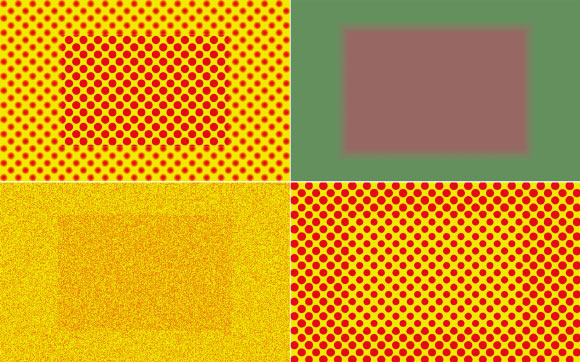According to a new study, what we see in the periphery, just outside the direct focus of the eye, may sometimes be a visual illusion.

Four examples of the uniformity illusion with — clockwise from top left — blurriness, color, density, and size. In these examples, the periphery is, respectively, blurrier, greener, less dense, or contains larger circles than the center. However, if you fixate the center of the image for a prolonged period of time, the peripheral stimuli seem to take on the properties of the central stimuli. Image credit: Marte Otten et al, doi: 10.1177/0956797616672270.
As we go about daily life, we generally operate under the assumption that our perception of the world directly and accurately represents the outside world.
But visual illusions of various kinds show us that this isn’t always the case. As the brain processes incoming information about an external stimulus, we come to learn, it creates a representation of the outside world that can diverge from reality in noticeable ways.
Dr. Marte Otten from the University of Amsterdam and her colleagues from the Netherlands, UK, Japan and the United States wondered whether this same process might explain why we usually feel as though our peripheral vision is detailed and robust when it isn’t.
“Vision in the fovea, the center of the visual field, is much more accurate and detailed than vision in the periphery. This is not in line with the rich phenomenology of peripheral vision,” the researchers said.
“We investigated a visual illusion that shows that detailed peripheral visual experience is partially based on a reconstruction of reality.”
The team’s results, published in the journal Psychological Science, suggest that even though our peripheral vision is less accurate and detailed than what we see in the fovea, we may not notice a qualitative difference because our visual processing system actually fills in some of what we ‘see’ in the periphery.
“Our findings show that, under the right circumstances, a large part of the periphery may become a visual illusion,” Dr. Otten said.
“This effect seems to hold for many basic visual features, indicating that this ‘filling in’ is a general, and fundamental, perceptual mechanism.”
Over a series of experiments, Dr. Otten and co-authors presented a total of 20 participants with a series of images.
The participants focused on the center of the screen — a central image appeared and then a different peripheral image gradually faded in.
They were supposed to click the mouse as soon as the difference between the central patch and the periphery disappeared and the entire screen appeared to be uniform.
The authors changed the defining characteristic of the central image in different experiments, varying its shape, orientation, luminance, shade, or motion.
The results showed that all of these characteristics were vulnerable to a uniformity illusion — that is, participants incorrectly reported seeing a uniform image when the center and periphery were actually different.
The illusion was less likely to occur when the difference between the center and periphery was large; when the illusion did occur on these trials, it took longer to emerge.
The participants indicated that they felt roughly equally sure about their experience of uniformity when it actually did exist as when it was illusory.
This suggests that the illusory experiences are similar to a visual experience based on a physical visual stimulus.
“The fun thing about this illusion is that you can to test this out for yourself,” Dr. Otten said.
“If you look up the illusion on www.uniformillusion.com you can find out just how real the illusory experience feels for you.”
_____
Marte Otten et al. The Uniformity Illusion: Central Stimuli Can Determine Peripheral Perception. Psychological Science, published online November 15, 2016; doi: 10.1177/0956797616672270







